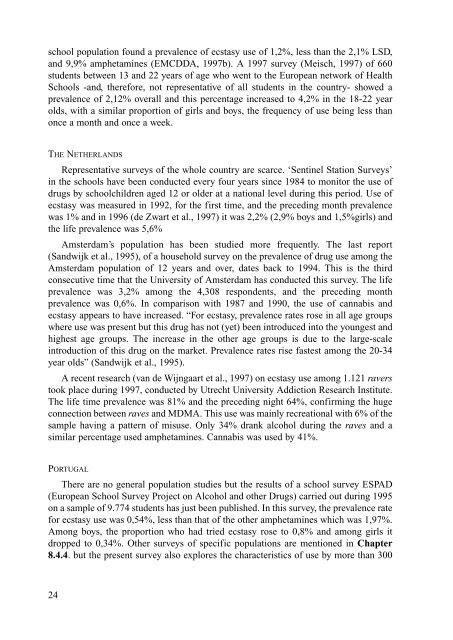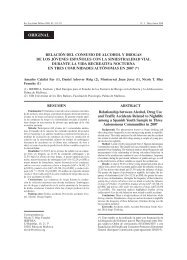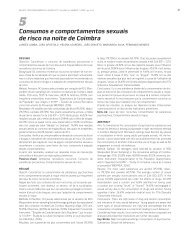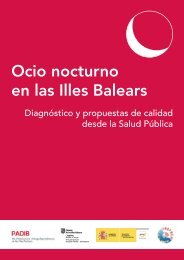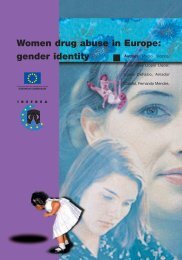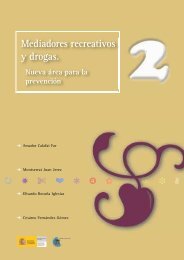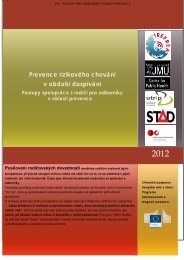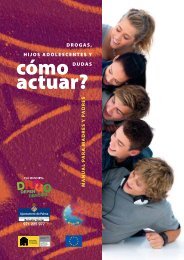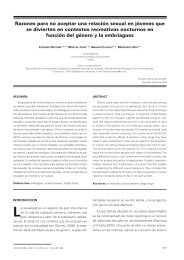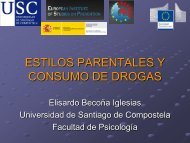Characteristics and social representation of ecstasy in Europe - Irefrea
Characteristics and social representation of ecstasy in Europe - Irefrea
Characteristics and social representation of ecstasy in Europe - Irefrea
You also want an ePaper? Increase the reach of your titles
YUMPU automatically turns print PDFs into web optimized ePapers that Google loves.
school population found a prevalence <strong>of</strong> <strong>ecstasy</strong> use <strong>of</strong> 1,2%, less than the 2,1% LSD,<strong>and</strong> 9,9% amphetam<strong>in</strong>es (EMCDDA, 1997b). A 1997 survey (Meisch, 1997) <strong>of</strong> 660students between 13 <strong>and</strong> 22 years <strong>of</strong> age who went to the <strong>Europe</strong>an network <strong>of</strong> HealthSchools -<strong>and</strong>, therefore, not representative <strong>of</strong> all students <strong>in</strong> the country- showed aprevalence <strong>of</strong> 2,12% overall <strong>and</strong> this percentage <strong>in</strong>creased to 4,2% <strong>in</strong> the 18-22 yearolds, with a similar proportion <strong>of</strong> girls <strong>and</strong> boys, the frequency <strong>of</strong> use be<strong>in</strong>g less thanonce a month <strong>and</strong> once a week.THE NETHERLANDSRepresentative surveys <strong>of</strong> the whole country are scarce. ‘Sent<strong>in</strong>el Station Surveys’<strong>in</strong> the schools have been conducted every four years s<strong>in</strong>ce 1984 to monitor the use <strong>of</strong>drugs by schoolchildren aged 12 or older at a national level dur<strong>in</strong>g this period. Use <strong>of</strong><strong>ecstasy</strong> was measured <strong>in</strong> 1992, for the first time, <strong>and</strong> the preced<strong>in</strong>g month prevalencewas 1% <strong>and</strong> <strong>in</strong> 1996 (de Zwart et al., 1997) it was 2,2% (2,9% boys <strong>and</strong> 1,5%girls) <strong>and</strong>the life prevalence was 5,6%Amsterdam’s population has been studied more frequently. The last report(S<strong>and</strong>wijk et al., 1995), <strong>of</strong> a household survey on the prevalence <strong>of</strong> drug use among theAmsterdam population <strong>of</strong> 12 years <strong>and</strong> over, dates back to 1994. This is the thirdconsecutive time that the University <strong>of</strong> Amsterdam has conducted this survey. The lifeprevalence was 3,2% among the 4,308 respondents, <strong>and</strong> the preced<strong>in</strong>g monthprevalence was 0,6%. In comparison with 1987 <strong>and</strong> 1990, the use <strong>of</strong> cannabis <strong>and</strong><strong>ecstasy</strong> appears to have <strong>in</strong>creased. “For <strong>ecstasy</strong>, prevalence rates rose <strong>in</strong> all age groupswhere use was present but this drug has not (yet) been <strong>in</strong>troduced <strong>in</strong>to the youngest <strong>and</strong>highest age groups. The <strong>in</strong>crease <strong>in</strong> the other age groups is due to the large-scale<strong>in</strong>troduction <strong>of</strong> this drug on the market. Prevalence rates rise fastest among the 20-34year olds” (S<strong>and</strong>wijk et al., 1995).A recent research (van de Wijngaart et al., 1997) on <strong>ecstasy</strong> use among 1.121 raverstook place dur<strong>in</strong>g 1997, conducted by Utrecht University Addiction Research Institute.The life time prevalence was 81% <strong>and</strong> the preced<strong>in</strong>g night 64%, confirm<strong>in</strong>g the hugeconnection between raves <strong>and</strong> MDMA. This use was ma<strong>in</strong>ly recreational with 6% <strong>of</strong> thesample hav<strong>in</strong>g a pattern <strong>of</strong> misuse. Only 34% drank alcohol dur<strong>in</strong>g the raves <strong>and</strong> asimilar percentage used amphetam<strong>in</strong>es. Cannabis was used by 41%.PORTUGALThere are no general population studies but the results <strong>of</strong> a school survey ESPAD(<strong>Europe</strong>an School Survey Project on Alcohol <strong>and</strong> other Drugs) carried out dur<strong>in</strong>g 1995on a sample <strong>of</strong> 9.774 students has just been published. In this survey, the prevalence ratefor <strong>ecstasy</strong> use was 0,54%, less than that <strong>of</strong> the other amphetam<strong>in</strong>es which was 1,97%.Among boys, the proportion who had tried <strong>ecstasy</strong> rose to 0,8% <strong>and</strong> among girls itdropped to 0,34%. Other surveys <strong>of</strong> specific populations are mentioned <strong>in</strong> Chapter8.4.4. but the present survey also explores the characteristics <strong>of</strong> use by more than 30024


